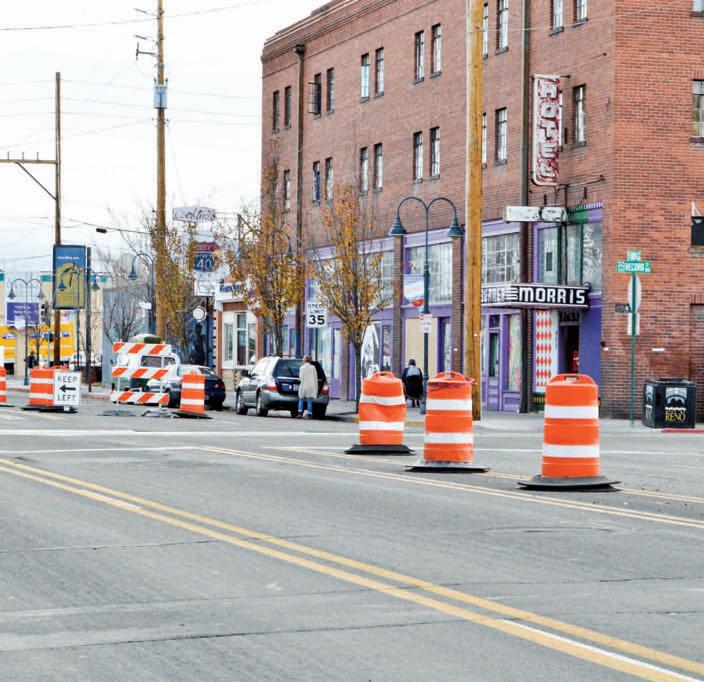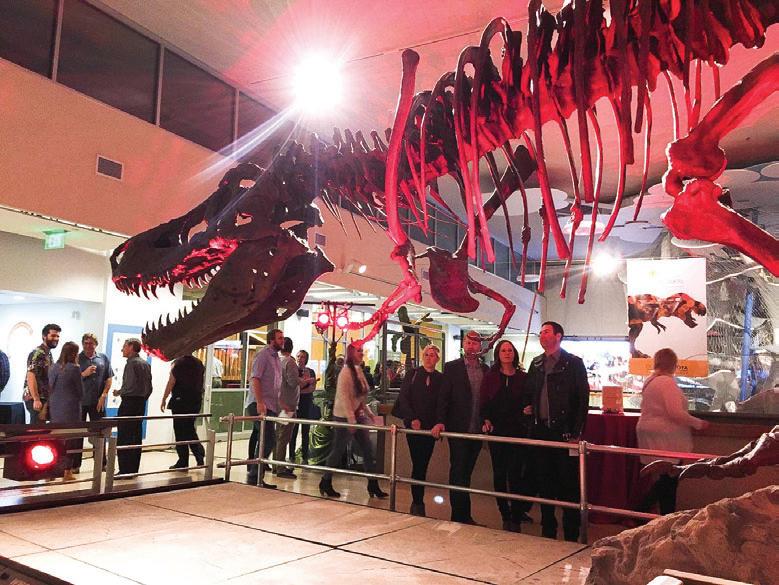
7 minute read
NEwS
from Nov. 22, 2017
UNR taRgets histoRic homes, agaiN
The administration of Marc Johnson at the University of Nevada, Reno is quietly seeking a vote by the Nevada Board of Regents to “pre-approve” the removal of some of Reno’s oldest residences from the campus-adjacent neighborhood between Interstate 80 and University Terrace.
Advertisement
The briefing paper attached to the Regents’ agenda item for its Nov. 30 meeting reads in part, “Given the university’s proximity to downtown, all of the parties wish to extend the university’s presence south to I-80 to help serve as a catalyst to revitalize land south of I-80 to downtown Reno.” Actually, many in the community tried to stop the university from changing the residential setting of that neighborhood. There was considerable activism around the issue in 2014.
In a lengthy online posting about the agenda item, Reno historian Alicia Barber provides information not included in the staff-written regents briefing paper, and also criticizes the campus’s failure to provide a “a transparent and inclusive process” for the public. She reports that two months ago, Johnson himself “suddenly announced to members of Reno’s Historical Resources Commission that the university had found a destination for five or six of the Center Street houses, and would be proceeding with a plan to move them there.”
The buildings at issue are 12 Queen Anne-style homes on Center, Lake and Eighth streets—six of them on the west side of Center—that date back to the 1890s. One of them is listed on the state and city historic registers, and others are eligible for listing on the National Register of Historic Places.
The campus has been eyeing the neighborhood for development in alliance with some redevelopment officials for many years (“More redevelopment,” RN&R, Oct. 15, 2009). Email addresses for regents can be found at https:// nshe.nevada.edu/leadership-policy/board-ofregents/current-regents/.
—Dennis Myers
talk shop
Small Business Saturday is Nov. 25. The day is a counterpart to Black Friday and Cyber Monday and was originally sponsored by American Express, which ran an extensive advertising campaign in advance of the first Small Business Saturday in 2010.
Locally owned businesses in the Truckee Meadows are promoting this year’s Small Business Saturday on social media. Events and sales are planned at retailers in midtown, inside the Basement and on Dickerson Road. See this week’s feature story on page 11 for a holiday gift guide featuring local businesses and artists. —Jeri ChaDwell
“Jungle Jim” Gibson opened the Morris Burner Hostel nearly four years ago. Today, he is working to raise around $50,000 to install sprinklers inside the building.
PHOTO/JERI CHADWELL
Hard road
Construction and code enforcement put heat on Reno’s Burning Man-themed hostel
it’s been nearly a year since the Regional Transportation Commission began work on the $58 million Fourth Street/Prater Way Bus RAPID Transit Project—a massive undertaking that involves moving utilities underground and creating ADA-compliant sidewalks, bike lanes and a dedicated center turn lane along a 3.1-mile stretch of the old Lincoln Highway through Sparks and Reno.
Dotted among the orange construction cones that have lined the length of the project route since January are signs—official ones and hand-painted—reading, “Business open during construction.”
Several businesses in Sparks and Reno have reported slow sales since the start of construction. In May, Cathy Langdahl, the owner of the Flower Bucket in Sparks, told the RN&R she feared her business might not last as long as the construction.
The project is scheduled to finish this summer—after a total of about 18 months of work. Michael Moreno, RTC public affairs administrator, said in a recent email interview that construction in Sparks is expected to wrap up by the end of the year, and work on the Reno side of the project will begin shortly thereafter.
At the Morris Burner Hostel, not far from the project’s Reno terminus, it will be a resumption of construction—and, according to owner Jim Gibson, a.k.a. “Jungle Jim,” the project has already taken a heavy toll on the business.
The backyard space of the Morris was torn up for several months on two occasions, during summer and again in early fall, as crews worked to run underground utilities as a part of the project. Through eminent domain, the RTC took a 10-foot easement running the length of Gibson’s property, from Record Street to Valley Road. The work resulted in the demolition of the Morris’ outdoor stage, and although it’s finished now, Gibson and the RTC are still involved in litigation over the amount of compensation he’s owed for it.
According to Gibson, the easement cost him more than a stage. He said it also permanently waylaid plans he had for other parts of the property.
“We were going to build a makers’ space,” Gibson said. “We were going to put a smaller version of the Generator that basically took up the parking lot behind the Studio on 4th and Abbey’s. That’s our property back there. We were going to put a makers’ space back there that you could drive through the center, roll-up doors on both ends, and have the welding and stuff on the bottom floor, and classrooms on the top. That’s gone away. We can’t do that now, because we can’t build on the easement.” Gibson said he feels like it’s a “David and Goliath situation,” citing a disagreement that occurred recently when he requested seismic measuring be done to ensure his building wasn’t damage during utility work.
“They just finished doing another project in our backyard, where they dug a giant pit,” he said. “I’m going to say it was probably 20 feet wide and maybe 30 feet long. It was 16 feet deep. And they dropped in this giant, giant, ram and pounded a 36-inch pipe underneath the railroad tracks. Oh, it was awful. And you know we got into a big to-do with them. I said, ‘Is it going to damage our building? Is it going to vibrate our building?’”
Gibson said he requested that staff from the seismology lab at the University of Nevada, Reno take measurements.
“They were all in favor until they realized that they would be at odds with—I believe that’s the case—they backed out once they realized that if they had measured seismic activity, that they would be going up against RTC as an engineering source,” he said.
FiRe aNd wateR
According to Gibson, as the date for commencement of work on the actual road in front of the Morris draws
nearer, his business is facing another challenge—this one involving the City of Reno.
Gibson opened a bar inside the Morris in 2016, but he hasn’t been able to sell drinks from it since last December.
“We put that in and, you know—with permits—and the health department signed off, and they gave us our cabaret and our liquor licenses,” Gibson said. “About six months after we’d been running the bar and doing a wonderful job—incredibly friendly and one of the nice bars in town— they came back and said we didn’t do a change of use. We did not know we had to, nor did they tell us. So they shut us down until we put sprinklers in.”
He said he expects it will cost around $50,000 to install them.
“We raised some money,” he said. “We raised about $10,000, which helps with all of the engineering and all of the stuff that goes up front. But it’s still a long ways from being done, and it’ll probably be another four or five months.”
At one point, Gibson said, he asked Mayor Hillary Schieve to look into whether or not the bar might be able to operate while funds for the sprinklers were being raised.
“She talked to fire and code, and everybody came back and said, ‘Nope, we’re not bending the rules,’” Gibson said, adding that he believes the 2016 fire at the Ghost Ship artist collective in Oakland—which claimed the lives of 36 people—played a role in the decision. “I’m sure a lot of this is the fallout of the Ghost Ship fire and them thinking we’re like Ghost Ship, which is so not true,” Gibson said. “We are so safe in that place. We bend over backwards. We have fire extinguishers in every room in the hotel. We have five exits out of that little place—emergency exits—and two more, non-emergency exits out of that little, tiny space. … So it’s not about safety. It’s about code. And code says when you do a change of occupancy, you have to bring your building to current standards. Current standards require sprinklers. So that’s kind of where we are.”
In the end, though, Gibson remains hopeful for his business. And while he still has concerns—like whether or not there will sufficient parking near the Morris—he thinks the overall effect on his neighborhood will likely be a positive one.
“Certainly as they clean it up more— the physical streets—it will become nicer and nicer, like midtown,” he said. “It’s getting there.” Ω


the way of the dinosaur

Adults crowded around Sue the T. rex during this year’s Chemistry of the Cocktail event at the Discovery Museum on Nov. 17. The annual event is a fundraiser for the museum. The goal for this year was $100,000.











